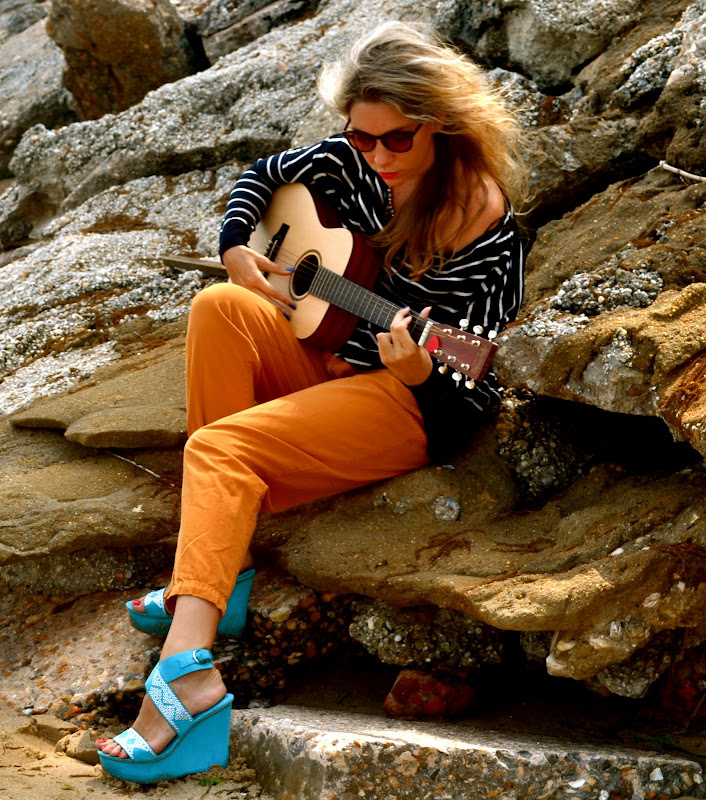
After more than a few years spent studying art, some topics become tiresome. I am ashamed to admit that, at one point, the sight of a Picasso collage was less than inspirational.

A few months ago, my interest was piqued anew with the Picasso: Guitars 1912-1914 exhibition at the MoMA in New York. Some time has passed since I visited the recently closed exhibition, but my wheels are still turning. One great thing about art is that there are always new ways to see things.

1912-1914 were years in which Picasso experimented heavily with guitars as subject matter, and during which time he produced the radical cardboard sculpture seen here.

Guitars remained part of Picasso's subject matter throughout his career, as evidenced by the array of works shown here.

Before the exhibition, I had never fully considered the question of why guitars were such an important aspect of Picasso's work.

For one, they closely resemble the human form, and provided a means for Picasso to draw correlations between animate and inanimate objects, as explained by Blake Gopnik in this review.

In this way, the guitar represents not only the instrument, but also the person who plays the instrument, and Picasso himself.

The guitar also symbolized Picasso's Spanish heritage.

"It's nothing, it's el guitare." --Picasso on whether his guitar works were paintings, sculptures, or collages

I'm wearing an H&M necklace, vintage pants, BCBG wedges, thrifted H&M sweater, and shades courtesy of Sunglasses Shop. The guitar is a Little Martin.

[Picasso images from theartblog.org, hrsbstaff.ednet.ns.ca, artknowledgenews.com, josettebouwer.edublogs.org, akneje.blogspot.com, and picassoandmatisse.com, respectively.]


Your sense of style is really good.
ReplyDeleteninest123 08.22
ReplyDeletetrue religion jeans, polo ralph lauren outlet, nike outlet, coach outlet, prada handbags, tiffany and co, coach purses, coach factory outlet, michael kors, burberry, michael kors outlet, nike air max, michael kors outlet, chanel handbags, polo ralph lauren outlet, michael kors outlet, longchamp outlet, ray ban sunglasses, burberry outlet online, nike air max, longchamp, michael kors outlet, true religion jeans, christian louboutin outlet, tory burch outlet, tiffany jewelry, oakley sunglasses, kate spade handbags, jordan shoes, prada outlet, longchamp outlet, replica watches, coach outlet, ray ban sunglasses, nike free, louboutin, oakley sunglasses, michael kors outlet, gucci outlet, louboutin outlet, louboutin shoes, kate spade outlet, true religion jeans, oakley sunglasses
nike roshe run, nike trainers, vanessa bruno, air jordan pas cher, nike air max, longchamp pas cher, nike roshe, michael kors, michael kors, nike blazer, sac longchamp, nike free run uk, north face, mulberry, nike free, tn pas cher, ralph lauren pas cher, north face, oakley pas cher, air max, michael kors, abercrombie and fitch, vans pas cher, sac guess, nike air max, louboutin pas cher, lacoste pas cher, longchamp, new balance pas cher, hermes, ray ban uk, nike air max, burberry, lululemon, ralph lauren uk, nike huarache, ray ban pas cher, hollister, air force, timberland, true religion outlet, converse pas cher, hogan, hollister pas cher
ReplyDeletewarriors jerseys
ReplyDeletesupra sneakers
fivefingers shoes
the north face jackets
minnesota vikings jerseys
nike huarache, http://www.nike-airhuarache.co.uk/
evening dresses outlet
celtics jerseys
bottega veneta wallet
prada sneakers
nike sneakers
chelsea football shirts
oakley sunglasses outlet
cartier watches
nike sneakers
kevin durant jersey
supra footwear
michael kors outlet, http://www.michaelkorsoutletcanada.in.net
kansas city chiefs jerseys
kyrie irving jersey
cheap wedding dresses
chanel outlet
hermes birkin
green bay packers jerseys
michael kors factory outlet, http://www.michaelkors-outlets.us.com